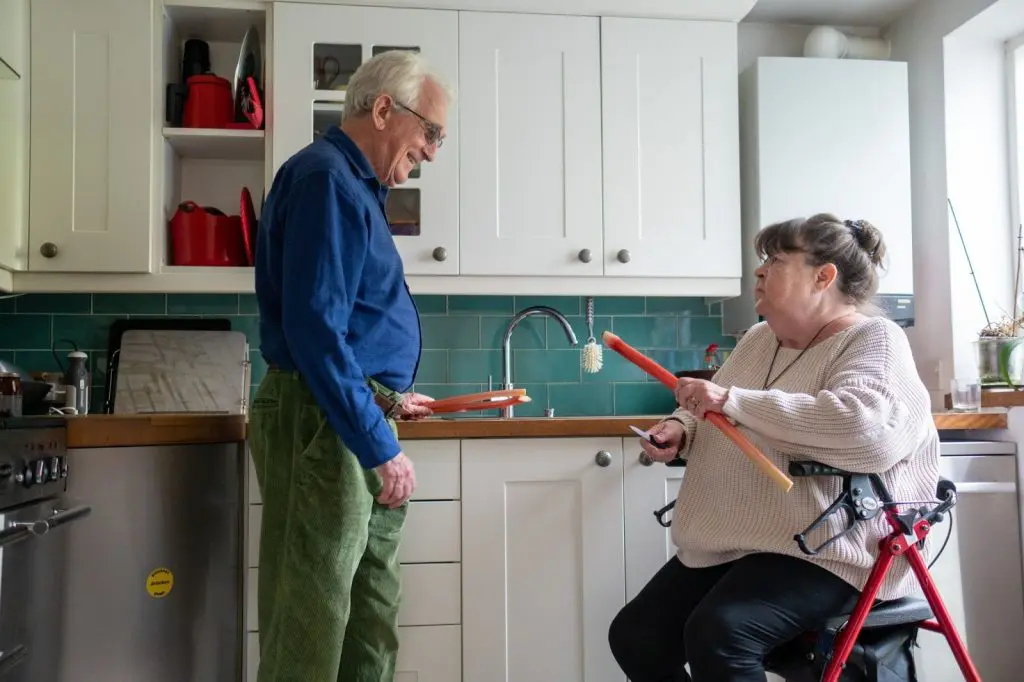
Building Support Systems Male Caregivers Actually Need
Read time: 10 minutes
Part 2 of “The 3.6 Million Male Caregivers Canada Forgot“
In Part 1, we looked at the invisible crisis facing 3.6 million male caregivers in Canada – men who are isolated, overwhelmed, and navigating support systems that weren’t designed for them. Now, let’s talk about solutions.
Canada’s 7.8 million caregivers represent one in four Canadians, and roughly 3.6 million of them are men.1 Yet when we design caregiver support programs, develop workplace policies, or create mental health resources, we rarely ask: what do male caregivers actually need?
The answer isn’t “nothing.” It’s not that men don’t need support – it’s that the support available doesn’t meet them where they are.
The System That Wasn’t Built for Them
Canadian healthcare and social service systems have slowly and inadequately begun addressing women’s caregiving burden. The Canadian Centre for Caregiving Excellence’s 2024 landmark study “Caring in Canada” surveyed over 3,000 caregivers and found that financial supports and mental health counselling were among the most pressing needs – yet four of five caregivers (80%) noted that free counselling and mental health supports would be important, with women and younger caregivers significantly more likely to find this helpful.2
While the majority of family caregivers are indeed women, the percentage of caregivers who are male are not insignificant. However, many programs are designed for mainly female caregivers in mind. Now, let’s be real – the world is full of instances where women are at a real disadvantage or face institutional bias. We are more used to talking about how we can better support women. However, in this article, we want to explore whether family caregiving is one area where it may be beneficial to have male-specific programming, or whether there is some work that can be done to create gender-neutral support for family caregiving.
What Male Caregivers Actually Need

Addressing the male caregiver crisis requires more than just acknowledging men care for family members. It requires understanding how men’s socialization, skills, expectations, and support-seeking behaviors create specific challenges.
Male-Specific Support Spaces Matter
Organizations like Homewatch CareGivers Canada have pioneered “The Male Caregiver Community,” an online support forum specifically for men.3 Attendance at male-focused programming is consistently higher than male participation in general caregiver support groups, not because men can’t benefit from mixed-gender groups, but because men are more likely to actually attend male-focused programming.
These don’t need to be elaborate programs. Men’s caregiver coffee groups. Online forums moderated by and for men. Peer support matching male caregivers with similar situations. Simple, accessible, and explicitly welcoming to men.
Practical, Skill-Based Training Helps

Men often respond better to concrete skill-building than emotional processing groups. According to caregiving experts, men will go to the internet more as a caregiving resource but are less likely to get formal caregiver training.3
Some ideas for skills-building topics include:
- Cooking classes specifically for male caregivers
- Household management workshops that don’t assume prior knowledge
- Step-by-step video guides for personal care tasks
- Equipment and technology training (medication management apps, emergency response systems)
- Financial planning for caregiving costs
Normalize Male Caregiving in Workplace Policies

Canadian data shows that 46% of caregivers in the workforce report needing time off to meet their caregiving responsibilities,4 but workplace culture often doesn’t expect men to be caregivers.
Women requesting reduced hours or flexible scheduling to care for family members may encounter bias – but it’s expected bias. The workplace has (somewhat) adjusted to the idea that women have caregiving responsibilities. Men making the same requests often face confusion, skepticism, or surprise.
A 2022 Canadian study found that women required workplaces to have at least five types of support to mitigate negative mental health outcomes from caregiving, while men only needed two or three types – yet men were less likely to access any support.5 The support existing isn’t enough. The culture must actively communicate that men should use it.
What workplaces should do:
- Explicitly mention male caregivers in caregiving leave policies
- Train managers to respond supportively when male employees request flexibility
- Feature male caregiver stories in internal communications
- Offer employee resource groups for caregivers that actively recruit men
- Track usage of caregiving benefits by gender to identify disparities
- Ensure male employees know about benefits without having to ask
The Movember Connection: Making This Part of Men’s Health
Movember exists because men’s health – physical and mental – requires specific attention. Men die younger. Suicide occurs at dramatically higher rates in males. Men underutilize mental health services. Men ignore physical symptoms until crisis.
The same patterns that make Movember necessary make the male caregiver crisis urgent.
According to Movember’s “Real Face of Men’s Health” report for Canada, more than two in five men (44%) living in Canada will die before the age of 75, with largely preventable causes being the leading contributors.6 The report emphasizes that when a man suffers, it’s not just his health on the line – it’s his partner, his kids, his parents (often women) who carry the weight. They’re losing sleep, taking time off work, sacrificing their own wellbeing. Caregivers are the invisible casualties of Canada’s men’s health crisis.6
Caregiving stress is a men’s health issue. Male caregiver isolation is a mental health crisis. The expectation that men should handle caregiving without support or acknowledgment contributes to the same toxic masculinity that prevents men from seeking help for depression, attending mental health appointments, or talking about suicidal thoughts.The Mental Health Commission of Canada has emphasized this connection, noting that mental health challenges are compounded for men facing unemployment, economic uncertainty, and caregiving stress.
This Movember, the conversation must expand beyond prostate cancer and suicide prevention to explicitly include caregiving as a men’s health issue.
A National Strategy Is Overdue
The Canadian Centre for Caregiving Excellence has been advocating for a National Caregiving Strategy since their launch in 2022. In the 2024 Federal Budget, Minister Chrystia Freeland committed the government to developing such a strategy.2
As this strategy takes shape, it must explicitly address the unique needs of male caregivers:
Policy Recommendations:
- Collect gender-disaggregated data on caregiver experiences, needs, and outcomes to understand how gender affects caregiving trajectories
- Fund male-specific caregiver programs alongside universal programs, recognizing that gender-neutral often means female-focused in practice
- Include male caregivers in strategy development through consultation, advisory roles, and lived experience input
- Address workplace discrimination against male caregivers through enforcement of existing protections and public awareness campaigns
- Integrate caregiving into men’s health initiatives like Movember, prostate cancer screening programs, and mental health campaigns
- Train healthcare and social service providers on the specific needs and barriers facing male caregivers
- Provide targeted outreach to older male caregivers, who are least likely to access available supports
- Support research on male caregiver experiences, particularly around mental health, social isolation, and help-seeking behaviors
Senior caregivers represent a particularly vulnerable group, with nearly one in five caregivers over the age of 65.2 These older male caregivers are least likely to access any services or supports – from home modifications to respite or transportation services. A National Caregiving Strategy that fails to reach them fails the men who need help most.
Seeing the Invisible: Moving Forward

When we picture a caregiver, we see a woman because most caregivers are women. But when we only see women, we fail the men who are also caring, also exhausted, also isolated, also struggling. We create systems that work reasonably well for 52% of caregivers and leave 46% invisible.
David, the retired electrician caring for his wife with Alzheimer’s, eventually found help. A neighbor mentioned a men’s caregiver group at the local community center. He attended skeptically. “I’m not a support group guy,” he said. But something about being in a room with other men – all caregiving, all struggling, all trying to figure out how to cook and clean and cope – changed things.
“We didn’t sit around crying, though some guys did sometimes, and that was okay,” he told us. “Mostly we traded tips. How to get someone to take medication when they’re refusing. What frozen meals are actually decent. How to get through the day when you wake up already exhausted. And just… knowing I wasn’t the only man doing this. That mattered more than I expected.”
What You Can Do
If you’re a male caregiver:
- You’re not alone. Reach out to the resources below.
- Seeking help doesn’t mean you’ve failed. It means you’re being smart about a hard job.
- Your mental health matters as much as the person you’re caring for.
If you know a male caregiver:
- Check in specifically about caregiving, not just “how are you?”
- Offer concrete help: bring a meal, sit with their loved one for an hour, help with yard work.
- Normalize talking about the hard parts of caregiving.
If you’re an employer:
- Make it clear that caregiving leave is for everyone, including men.
- Train managers to respond supportively when male employees need flexibility.
- Feature male caregiver stories in your communications.
If you’re a healthcare provider:
- Address male family members directly in care planning.
- Screen male caregivers for depression and burnout.
- Connect them with male-specific resources.
If you’re a policymaker:
- Include male caregivers explicitly in caregiving strategy development.
- Fund programs that serve caregivers of all genders.
- Collect data on how gender affects caregiving experiences.
This Movember, while we’re talking about prostate cancer and mental health and suicide prevention, let’s also talk about the 3.6 million male caregivers Canada forgot. Let’s build support systems that see them. Let’s create spaces where they belong. Let’s acknowledge that caring for others – while watching them decline, while learning new skills, while grieving and adapting and surviving – is one of the most difficult things anyone can do, regardless of gender.
The male caregivers are already here, already caring, already struggling.
It’s time we actually saw them.
Resources for Male Caregivers in Canada
Canadian Centre for Men and Families
Peer support groups and counselling specifically for men
Website: https://menandfamilies.org/
Homewatch CareGivers Canada – Male Caregiver Community
Online support forum specifically for male caregivers
Website: https://www.homewatchcaregivers.com
Canadian Centre for Caregiving Excellence
Comprehensive resources and advocacy for all caregivers
Website: https://canadiancaregiving.org/
Movember Canada
Mental health resources and crisis support
Crisis line: 1-833-456-4566 (toll-free, any time)
Text: 45645 (4pm-midnight ET)
Website: https://ca.movember.com/mens-health/mental-health
Mental Health Commission of Canada
Men’s mental health resources and advocacy
Website: https://mentalhealthcommission.ca/
Talk Suicide Canada
24/7 crisis support
Phone: 1-833-456-4566
Text: 45645 (4pm-midnight ET)
Footnotes
- Statistics Canada. (2020). “The Daily — Caregivers in Canada, 2018.” In 2018, approximately one in four Canadians aged 15 and older (or 7.8 million people) provided care to a family member or friend. https://www150.statcan.gc.ca/n1/daily-quotidien/200108/dq200108a-eng.htm ↩
- Canadian Centre for Caregiving Excellence. (2024). “Landmark study finds financial and mental health supports among most pressing needs for caregivers in Canada: Caring in Canada.” https://canadiancaregiving.org/media-release-caring-in-canada/ ↩ ↩2 ↩3 ↩4
- Planned Lifetime Advocacy Network. (2013). “Appreciation & Resources for Male Caregivers.” Scott McNabb, Executive Director of Homewatch CareGivers Canada, discussed The Male Caregiver Community online support forum. https://plan.ca/2013/11/13/appreciation-resources-for-male-caregivers/ ↩ ↩2
- Scotiabank. (2024). “INFOGRAPHIC | Caregiving in Canada.” 46% of caregivers in the workforce report needing time off to meet their caregiving responsibilities. https://enrichedthinking.scotiawealthmanagement.com/2024/10/01/infographic-caregiving-in-canada/ ↩
- Li, L., Lee, Y., & Lai, D.W.L. (2022). “Mental Health of Employed Family Caregivers in Canada: A Gender-Based Analysis on the Role of Workplace Support.” Journal of Family Issues. https://pmc.ncbi.nlm.nih.gov/articles/PMC9554159/ ↩
- Movember Foundation. (2023). “The Real Face of Men’s Health Report – Canada.” https://fatherandthreesons.ca/movember-foundation/ ↩ ↩2
- Mental Health Commission of Canada. (2020). “Movember reminds us to continue investing in men’s mental health.” https://mentalhealthcommission.ca/statements/21562-movember-reminds-us-to-continue-investing-in-mens-mental-health/ ↩
